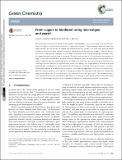From sugars to biodiesel using microalgae and yeast
Author(s)
Barton, Paul I.; Gomez, Jose Alberto; Hoeffner, Kai
DownloadBarton_From sugars.pdf (1.279Mb)
PUBLISHER_CC
Publisher with Creative Commons License
Creative Commons Attribution
Terms of use
Metadata
Show full item recordAbstract
The economic production of algal biofuels requires novel strategies, such as microbial consortia and synthetic ecologies, to boost the productivity of open pond systems. These strategies have not been fully explored partly due to the lack of reliable and predictive process models. This study uses genome-based metabolic networks to build a process model of a raceway pond. This process model is used as a discovery tool for novel process strategies. First, an algal monoculture with flue gas sparging is modeled. Then, an oleaginous yeast monoculture is modeled. The yeast monoculture is O[subscript 2] limited and the presence of algae in the culture would result in better resource utilization. Next, an algal/fungal raceway pond with a feed of cellulosic glucose is explored. Finally, an oleaginous yeast that can consume a glucose/xylose mix, resulting from the hydrolysis of lignocellulosic waste, is modeled. This model predicts biomass and lipids productivities comparable to those reported in the literature. Assuming 50% yield loss due to contamination and invasion, a simple economic analysis shows that an algae/yeast coculture can produce biodiesel at competitive prices, $2.01 per liter for pure glucose and $1.44 per liter for the sugar mix, whereas the algae monoculture can do so only at very short distances from a flue gas source. This modeling framework will enable the use of optimization algorithms in the design of open pond systems in the near future and will allow the exploration of novel strategies in bioprocesses employing microbial communities.
Date issued
2015-09Department
Massachusetts Institute of Technology. Department of Chemical EngineeringJournal
Green Chemistry
Publisher
Royal Society of Chemistry
Citation
Gomez, Jose A., Kai Hoffner, and Paul I. Barton. “From Sugars to Biodiesel Using Microalgae and Yeast.” Green Chem. 18, no. 2 (2016): 461–475. © 2016 Royal Society of Chemistry
Version: Final published version
ISSN
1463-9262
1463-9270